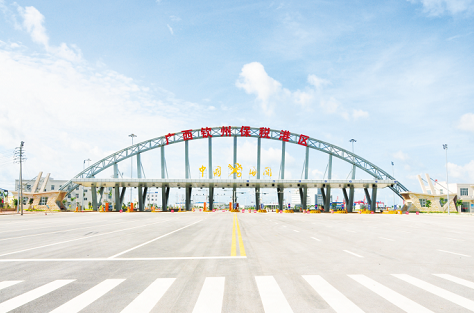


Chongqing-Guangxi economic ties have never been closer: fresh fruits from Southeast Asia are flowing through Guangxi’s Qinzhou Port into Chongqing by sea-rail freight trains, while container ships loaded with auto parts from Chongqing are leaving the Port for overseas destinations. Guangxi and Chongqing, riding on the construction of New International Land-Sea Trade Corridor (ILSTC), are joining hands to boost trade development through opening up.
Connectivity holds the key to ILSTC construction. Upon the inception of sea-rail freight service, Guangxi Qinzhou Free Trade Port Area (GQFTPA) has been working to turn itself into a hub port in ILSTC network, and recently breakthroughs in land-sea combined transportation, efficiency scale-up and fee cut attended its efforts. Chen Min’er, Secretary of the CPC Chongqing Municipal Committee, lauded the progress during his investigation in GQFTPA on July 8.
Improved Infrastructure
One week before the investigation, the Guangxi Qinzhou Container Central Station was officially put into operation, which marked the seamless connection of sea-rail transportation and rail-road transportation in Qinzhou Port and solved the last mile problem facing sea-rail transportation.
ILSTC started operation in 2017 and has since been rapidly swelling the ranks of container trains from Qinzhou Port to Chongqing, Chengdu and other cities in southwest and south central China, with 2018 cargo throughput exceeding 100 million tons. That said, the existing infrastructure fails to keep abreast with the fast-growing needs of shipment.
To remove this bottleneck, Qinzhou Port is speeding up the construction of major infrastructure projects including Qinzhou Container Central Station. The 900 million yuan project, covering over 1,200 mu (0.8 km2), consists of two parts: Eastern Station operation zone and the one in Port area. The former will house a new loading-unloading siding with an effective length of 850 m and a 32,000 m2 container yard, mainly meant for switching container movements between rail and road. The latter will see erected four loading-unloading sidings and a 120,000 m2 container yard, mainly for switching container movements between sea and rail.
Once the Station is completed, Qinzhou Port will be capable of handling 1.05 million TEUs annually, up from 150,000 TEUs now; or to put it on a daily basis, there will be an increase from 4 to 20 trains. Besides, Qinzhou Port will be able to marshal, load & unload and dispatch an entire train and integrate supporting logistics service, container cleaning & repairing, customs clearance & inspection and other port functions. The data switch backed by information system will actualize the seamless connection among container transportation of sea, rail and road, cutting more than 20% of the port-rail logistics cost.
Coming in the wake of the projects accomplished is the construction of a 100,000-ton east two-way shipping channel and a 200,000-ton container terminal as well as its supporting shipping channel. These endeavors will gear up the infrastructure of Qinzhou Port for the ever-enlarging international container ships.
“Tailored service” quickening customs clearance
International container ships carrying imported fruits can be let pass on the day of arrival as soon as customs clearance is done on an inspection platform tailored for ILSTC routes. This efficient clearance has been a regular practice since May in Qinzhou Port.
“We have had goods carried along ILSTC routes prioritized to undergo customs inspections, and the import clearance for them can be scheduled 24 hours in advance”, said Jiang Yuxiang, Section Chief of Qinzhou Port Customs. To expedite the procedure, the Customs has rolled out a suited channel for ILSTC routes in clearance, inspection and logistics monitoring, improved human resources integration and made better use of mobile inspection equipment. “Now, it costs 24 hours less on average for goods listed in one declaration form”, added Jiang.
According to a summary of Qinzhou on 2018 ILSTC construction, the entirety of clearance within the jurisdiction of Qinzhou Port Customs takes 169.91 hours, a figure that is, down 36.47% though, above national and Guangxi’s averages. Red tape in clearance represents an objective constraint on further smoothing ILSTC routes. Therefore, the Customs of Qinzhou Port this year continues to press ahead with higher efficiency and lower fees in a way that streamlines clearance procedures.
At present in GQFTPA, 99.9% of importers and exporters resort to paperless filing; the mobile payment rate remains above 95%; 100% of importers and exporters, a target hit sooner than expected, finish customs declaration at “international trade single windows”.
Rewards following fee cut
“We currently focus on the cutback in administrative fees and loading & unloading charges, yet other items also need, sort of, slash in charges”, said Wang Xiongchang, Standing Deputy Director of Guangxi Bonded Area Management Committee. It is also learned that port charges occurred in GQFTPA in 2018 decreased by nearly 40% year over year.
The charges will drop further with the recent opening of the Station and clearance facilitation. Moreover, mechanisms, including regional cooperation between provinces, introduced by Qinzhou Bonded Port has promoted fee cuts at critical logistics nodes along the ILSTC routes. So far, freight rates of ILSTC sea-rail trains have fallen by 10% to 30%.
Import and export trade in Qinzhou Port also secured a sound momentum of development, gaining from ILSTC construction. The first half of 2019 saw the throughput of GQFTPA reached 33.65 million tons, up 30.48% year over year; container throughput stood at 1.27 million TEUs, up 17.87% from last year, while 251,800 TEUs of that total were sent overseas, 2.86% high than last year.
On July 12, Liu Jun, Commercial Counselor of the Department of Asian Affairs of the Ministry of Commerce noted on a conference that ILSTC is shifting onto the track of cross-border and cross-region cooperation, and each breakthrough made by Qinzhou Port in ILSTC construction would drive Guangxi or even western China at large to step up the formation of a new opening-up and development pattern.
( Written by Xu Junhao / Translated by Cen Haobin)
Source:CHINA-ASEAN PANORAMA
桂ICP备14000177号 Copyright@2006-2013 Guangxi China-ASEAN Panorama Magazine Agency Co., Ltd. All Rights Reserved